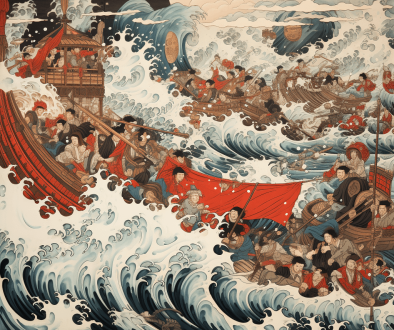Kamakura
The period in Japan known as the Kamakura period took place approximately between 1185–1333 AD. This period was when samurai power was at its height, and the country was ruled by the feudal military government, appointed by the first shogun Minamoto no Yoritomo in 1192. The heads of this military government were the shoguns. The first 3 shoguns were from the Minamoto clan, and this period was known as Kamakura because that was the city they stayed in.

The Kamakura period is significant because it was the first time that the samurai class emerged as an important factor in Japanese politics.

The events of this period are also of great interest to scholars of religion, as it saw the first use of missionary activity on a large scale since Buddhism was introduced to Japan centuries earlier. Buddhist monks typically traveled from China through Southeast Asia and then on to Japan during this period.
This section will focus on one specific event during this period, which is also one of the more interesting ones historically speaking. The Hōjō clan rose to power in Kamakura and exerted considerable influence over the government for several decades before being driven out by Emperor Go-Daigo’s army led by Kusunoki Masashige.
Key Features & Characteristics, Connected to the Daimyo, Samurai, and Feudalism
The Kamakura Period in Japan was characterized by the increased power of the shogun. This period had a major impact on Japanese history and had a major contribution to the development of feudalism.
During this period, samurai were influential to how society was organized. During this era, samurai were held in high esteem and given privileges that people who weren’t born into the warrior class didn’t have.
This era also marked the increased importance of Japanese Buddhism. The Kamakura Period resulted in a limited number of monks being ordained because there was no Emperor or Imperial Court to sponsor them anymore. Buddhist monasteries became centers for education during this time period, where they taught students about Confucianism, Chinese writing systems, art, music, math, etc., which helped prepare them for work
Possible Causes of the Kamakura Period
There are many possible causes for this period, but some historians believe that the true cause was the Minamoto family’s victory over the Taira family.
The factors that led to this victory were both political and military. The Minamoto family had achieved political advantage by keeping an alliance with other warrior families, while the Taira had offended key people in Kyoto through their arrogance and greed.
This might have caused them to be overthrown easily by the Minamoto warriors who then established their own government in Kamakura instead of Kyoto.
Society and Economy during the Kamakura Period
This era is characterized by significant growth in power for the samurai class. The samurai had grown very powerful by this point in time, and they were in charge of managing the country’s economy, laws, and military.
The Kamakura period was also a time in which Japan’s society became more hierarchical than before. The emperor and other elites controlled most of the wealth and resources, while peasants were essentially destitute.
Conclusion and Lessons Learned the Period
Kamakura is the period in Japanese history when samurai took control of Japan. There were many advancements in this period, including the development of feudalism and the establishment of long-distance trade with Southeast Asia. Dictatorships always fall, and even with the few that remain in today’s world, maybe history will repeat itself.



